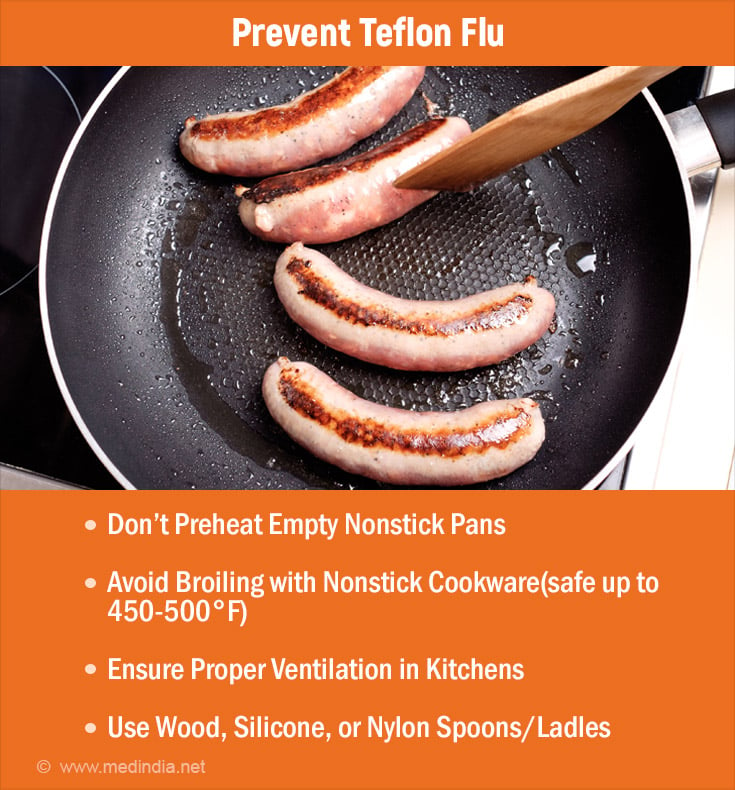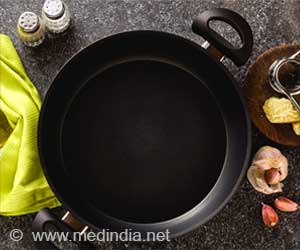- Fumes from Burning Plastic, Welding, and "Teflon Flu" - (https://www.poison.org/articles/fumes-from-burning-plastic-welding-and-teflon-flu-223)
- Polymer Fume Fever - (https://www.ncbi.nlm.nih.gov/books/NBK594276/)
About
In the United States, there has been a marked increase in cases of polymer fume fever, commonly known as "Teflon flu". This rare illness, caused by inhaling fumes from overheated nonstick pans, has seen a significant rise, according to sources like the Washington Post and New York Post(1✔ ✔Trusted Source
Fumes from Burning Plastic, Welding, and "Teflon Flu"
Go to source).
Did You Know?
Overheated nonstick pans can release harmful fumes causing polymer fume fever. #teflonflu #medindia
What is Polymer Fume Fever/Teflon Flu?
Polymer fume fever, often referred to as Teflon flu, occurs when individuals inhale toxic fumes released from overheated polytetrafluoroethylene (PTFE), the material used in nonstick coatings such as Teflon. Symptoms usually manifest within 12 to 24 hours after exposure. Though these symptoms are generally temporary, the condition is frequently mistaken for the common cold or flu, leading to under-reporting. Some typical symptoms include(2✔ ✔Trusted Source
Polymer Fume Fever
Go to source):
- Fever
- Muscle Pain
- Shortness of Breath
- Headaches
- Chills
- Chest Tightness
- Dry Cough
Recognizing Symptoms and Recovery
Symptoms of polymer fume fever typically appear within a few hours of exposure but can be delayed up to 24 hours. Despite these symptoms, laboratory tests and chest radiographs often show normal results, though some cases may exhibit leukocytosis and pulmonary edema, according to US govt. Most patients recover fully within a few days; severe outcomes are rare.
How Nonstick Cookware Contributes to Polymer Fume Fever
Nonstick cookware, coated with PTFE, belongs to the broader category of per- and poly-fluoroalkyl substances (PFAS), which are known for their environmental persistence and potential health risks. When PTFE-coated pans are heated beyond 500 degrees Fahrenheit, they can release harmful vapors. These fumes consist of complex oxidized fluorinated substances, emphasizing the need to avoid heating nonstick pans to high temperatures.
Recommended Precautions to Prevent Teflon Flu
Despite the U.S. Food and Drug Administration (FDA) asserting that normal cooking temperatures pose no known risk, studies, including those from Germany, have demonstrated increased PFAS emissions at higher temperatures. To mitigate risks, experts suggest:
- Avoiding the preheating of empty nonstick pans.
- Not using nonstick cookware for broiling, as they are generally safe up to 450 or 500 degrees Fahrenheit.
- Ensuring good ventilation by using exhaust fans or opening windows while cooking.
- Using utensils made of wood, silicone, or nylon to prevent scratching the nonstick surface.

Birds are particularly vulnerable to the fumes from overheated nonstick cookware, and exposure can be fatal. This sensitivity is reminiscent of past practices where canaries were used to detect toxic gases in coal mines. Therefore, pet birds should be kept away from the kitchen while cooking.
The Importance of Awareness and Updated Guidelines
The rising number of polymer fume fever cases highlights the necessity of using nonstick cookware responsibly and understanding the associated risks. In response to health concerns related to cookware, the ICMR-National Institute of Nutrition (NIN) in India has revised its "Dietary Guidelines for Indians" to incorporate new scientific insights and adapt to evolving food habits. The ICMR guidelines mentioned the standard heating temperature saying that heating food above 170 C in Teflon-coated nonstick pans poses health risks. It recommended people follow cooking guidelines correctly to avoid poisonous fumes from being released into the air.
In conclusion, the increase in polymer fume fever cases, or Teflon flu, underscores the importance of being aware of the risks associated with nonstick cookware. By following safety guidelines and staying informed, individuals can reduce risks and practice safer cooking methods.







